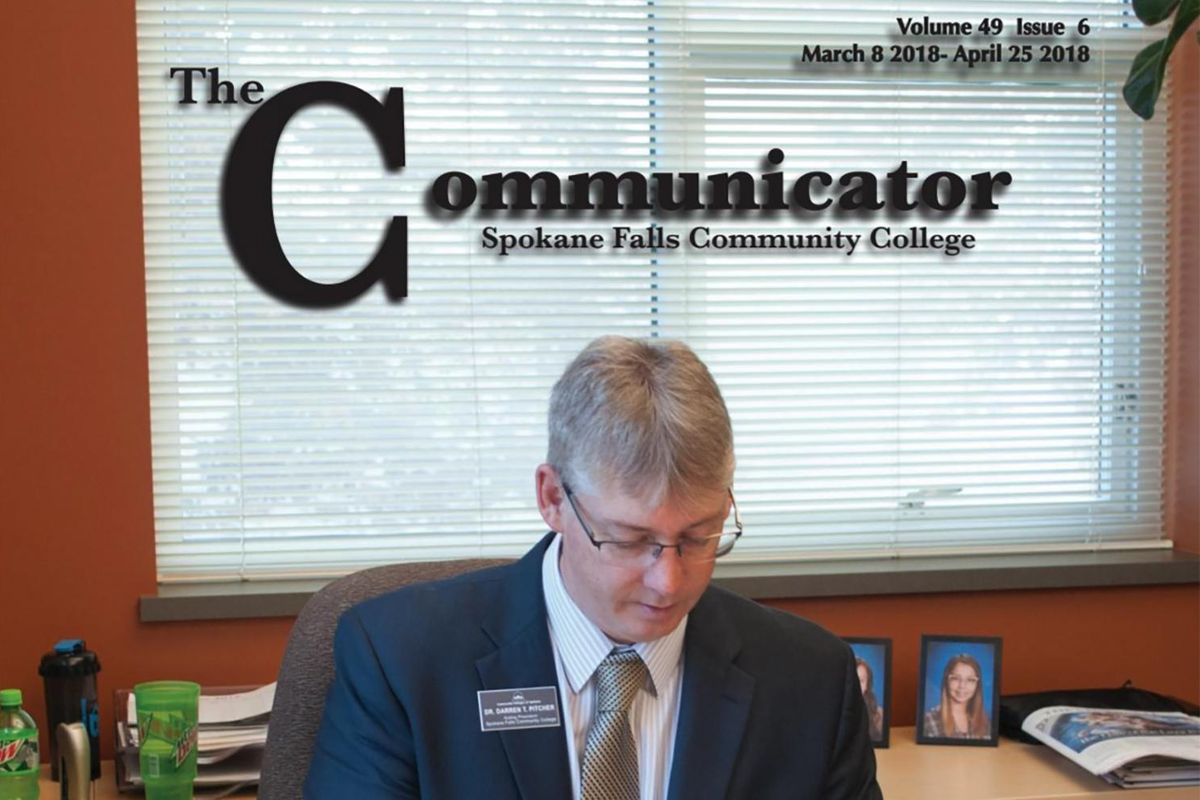SFCC officials determine student newspapers covering Pitcher scandal weren’t stolen

Campus security officials at Spokane Falls Community College have determined that hundreds of copies of the student newspaper were not stolen in early April, as student journalists had suspected.
About 400 copies of the March 8 issue of the Communicator disappeared from the racks at an unusually rapid pace on April 2 and April 3, as students and staff were returning to campus after spring break. The issue featured an unflattering front-page story about Darren Pitcher, who resigned as SFCC’s acting president in February amid allegations of sexual assault and harassment, and student journalists believed someone stole the papers to hide coverage of the scandal.
But whoever took those papers wasn’t technically stealing them because they appeared “free for the taking,” SFCC’s campus safety director, Kenneth DeMello, said in an email Wednesday. The first copy of each Communicator issue is free to anyone who wants it, and additional copies are supposed to cost 50 cents each, but DeMello said the rule was not clearly stated on the racks or in copies of the issue that went missing.
SFCC’s current acting president, Nancy Szofran, said in an interview Wednesday that security guards had searched for the missing papers in trash cans and offices, all to no avail. Later Wednesday, DeMello said there are no surveillance cameras in that area.
Szofran said one employee did admit she had thrown away copies of the Communicator over spring break, thinking they were old issues.
“Her intent was cleaning up,” Sozfran said. “It wasn’t to destroy the newspapers.”
Some students and journalism instructors have cried foul at school officials’ handling of the missing newspapers.
On April 6, Szofran wrote in an email to faculty members that “SFCC does not condone nor tolerate destructive behaviors that include vandalism or theft of college property,” and she explained the protocol for reporting such incidents to campus security.
But she also took the opportunity to question the judgment of the student journalists, and she made clear that some school employees were troubled by the publication of the Pitcher story.
“I regret the characterization of the theft (which was wrong) as an attack on students’ First Amendment rights,” Szofran wrote. “I believe this incident is a clash of values – personal value systems. The concern related to me by some students and employees was not the article on former Acting President Pitcher but the photograph that accompanied the article.”
The photo, a generic shot of Pitcher sitting at his desk, included a glimpse of two small, framed yearbook portraits of his young daughters that sat on a bookshelf behind him. To some counselors and faculty members, Szofran said Wednesday, this detail made the photo inappropriate for the front page, especially because one of Pitcher’s daughters was expected to visit the campus as part of a field trip that week.
“Those who were concerned about the adolescent daughters being pictured felt that it was extremely unfair to involve them, and to embarrass them, and to have them come on campus and be caught unaware with their father in the picture there,” Szofran said.
In her email to faculty members, she wrote: “ ‘Can’ the newspaper legally print the photograph? Yes, but ‘should’ they is my question.”
That criticism was misplaced, according to the Pacific Northwest Association of Journalism Educators, a professional organization that includes journalism instructors and student-newspaper advisers from across the state, including SFCC’s Jason Nix, who first complained about the alleged thefts in a campuswide email.
Last week, 20 members of PNAJE signed a letter to Szofran saying the staff of the Communicator had committed no journalistic malpractice by including the photo of Pitcher, even with his daughters’ portraits in the background.
“To be sure, journalists are not above scrutiny, and we must be held accountable for our mistakes,” their letter states. “But journalism students who have not failed in their journalistic mission should not be criticized unfairly, as they were on your campus. We ask that you reconsider your stance on this matter – and reaffirm in unequivocal terms that you won’t tolerate the theft of student newspapers – so that we may strengthen rather than further undermine this important cornerstone of our democracy.”
Szofran said she respects the student paper’s editorial independence but felt school officials needed to share their concerns about the photo.
“We want to be sensitive to that,” said Magdalena Clough, the Communicator’s editor in chief. “However, we stand by our legal rights to print what we did.”